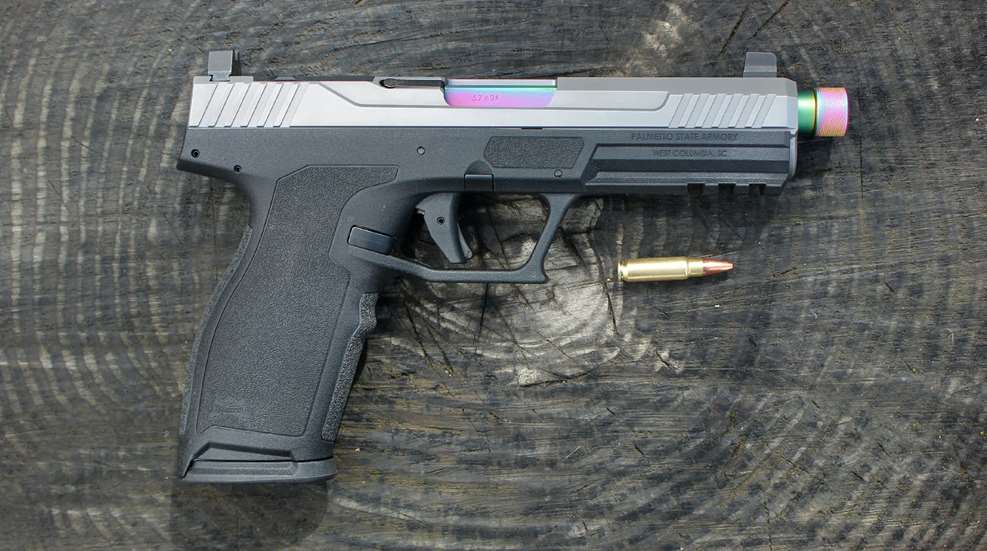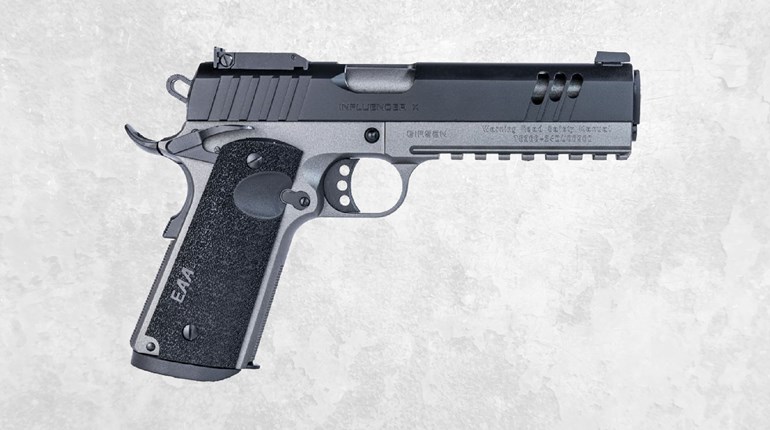
Recently we took a look at five defensive pistol sub-calibers that are commonly available in the United States. The conversation included .22 LR, .22 Mag., .25 ACP, .32 ACP and .380 ACP, their unifying feature being that they all generate less recoil than the ubiquitous 9 mm cartridge. But recently we've seen another sub-caliber round making substantial gains in the self-defense community. It's a little bottle-neck, center-fire-cartridge known as the FN 5.7x28 mm, or just 5.7x28 mm. Looking for all the world like a rifle round that shrank in the wash, it fires 0.224-cal. bullets at relatively high speeds with bullet energy levels that overlap with those of the 9 mm.

From left: .22 LR, .22 Mag., 5.7x28 mm, .32 ACP, .380 ACP and 9 mm.
The 5.7x28 mm was developed by FN Herstal to meet a NATO request sent out in 1989 for a new round to replace the 9 mm cartridge. NATO was looking for a round with a longer effective range, improved accuracy, increased magazine capacity, and they wanted it to be capable of firing armor piercing bullets. Launched in 1990, the 5.7x28 mm basically does everything NATO asked. It shoots about two times faster than 9 mm, it has a flatter trajectory, it produces about a third less recoil and pistol magazines can hold 20 or more rounds.

Defense and practice grade 5.7x28 mm is now available from a variety of manufacturers.
However, this cartridge did not start to catch on with civilian self-defenders here in the United States until much more recently. For many years, the only firearms chambered in this caliber and ammunition produced were manufactured by FN. And though they are well made, they're also relatively expensive. The FN Five-seveN pistol, which is now available in a Gen 2 configuration, is currently selling for around $1,400.

Bullet types for the 0.224-caliber 5.7x28 mm include full-metal jacket, hollow point, polymer tipped jacketed frangible and polymer tipped hollow points.
In 2019, Ruger breathed a fresh interest into this caliber with the release of the Ruger 5.7 pistol, which has a noticeably lower suggested retail price of $899. The 5.7x28 mm was finally adopted as a NATO-standard cartridge in 2021 as more gun manufacturers were adding this caliber to their catalogs. As of this writing, the hip-holster-sized pistols available include the previously mentioned FN and Ruger offerings, along with Palmetto State Armory's (PSA) Rock 5.7 series, the Smith & Wesson M&P 5.7 and the recently released Tisas PX-57.

The PSA magazine shown here holds 23 rounds plus one in the chamber.
Not too long ago the 5.7x28 mm ammunition selection was quite limited and prices were noticeably higher than the 9 mm cartridge it was intended to replace. But these days practice and defense-grade loads are available from several companies in addition to FN's offerings, including loads from Federal Premium, Fiocchi, Hornady and Speer. This broader selection has worked to bring prices down.

The PSA Rock 5.7 RK1 ships with a threaded barrel, optics-ready slide and two 23-round magazines.
Right now practice-grade 9 mm is selling for about $0.25 to $0.30 a round with premium defense-grade hollow points in the $1.25 per shot range. The 5.7x28 mm loads I found online include practice loads at around $0.85 each with defensive loads topping out at around $1.25 per round. This means it’s going to be about $0.50 more per shot to practice with 5.7x28 mm. However, it's in the same price range as .45 ACP plinking loads. So practice-grade loads in this caliber do cost more but costs are still within handgun cartridge parameters.

PSA offers additional drop-in barrels in different finishes with, or without, threaded muzzles.
With a reasonable number of pistols to choose from and a solid ammunition selection available at typical pistol prices, I was ready to give this cartridge a try. The test gun I went with was a two-tone, optics-ready PSA Rock 5.7 RK01 (Model RK01-51655140298) which arrived with a threaded 5.2" barrel, optics-height sights and a pair of blued steel 23-round magazines. You can read about the pistol's features, the Swampfox Optics Justice II red dot and a full range report here.

This Muddy River Tactical Kydex holster sized for the PSA Rock 5.7 pistol will accommodate most optics and a threaded barrel.
After the first range test was complete, I put the pistol, optic and magazines through a second battery of tests using a flush-fit 4.7" barrel provided by PSA. The 0.5" shorter barrel seemed to be a more logical fit for daily carry. This proved to be the case when packing the Rock 5.7 using a tension adjustable Muddy River Tactical inside-the-waistband Kydex holster ($59.99 as shown). Available in a variety of finishes, it has a sleek, uncomplicated profile with a wide polymer belt that slips comfortably into place and then stays put until intentionally removed. The holsters ship with optics cutouts and they will accommodate a threaded barrel. I appreciated the extra port at the top which allows the holster to have a slightly forward cant. This makes it much more comfortable to wear for my body shape when sitting. The only mistake I made with this Muddy River holster was not including one of the Kydex magazine pouches in the order ($24.95).

The PSA Rock 5.7 RK1 fired accurately and reliably with all ammunition, barrels and magazines tested.
The 4.7" barrel test, using typical bullet weights and velocities, was wholly uneventful in that there were no jams, failures or malfunctions of any kind either pistol or ammunition related. Bullet velocity and energy levels were slightly lower than those of the 5.2" barrel but the accuracy was still top notch. Here are the results using a Garmin Xero C1 Pro chronograph to measure bullet speeds:

These days, polymer-framed subcompact and compact size pistols chambered for the 122-year-old 9 mm cartridge are the standard by which all other defensive handguns are measured, and for several good reasons. The cartridge is thoroughly vetted, generates moderate levels of felt recoil and it can be effective from a variety of barrel lengths ranging from around 2.5" to 5" in length. The 9 mm is now the preferred sidearm caliber for law enforcement agencies and military forces around the world. Ammunition is usually more affordably priced than other centerfire calibers and it’s easy to find. Pistols in this caliber are available at various prices with double-stack ammunition capacities of 10-, 12- or 15-rounds. In short, 9 mm pistols are tough to beat if you can work with them comfortably.
However, for some folks, managing felt recoil is their top priority. When 9 mm levels are too intense due to age, injuries or other circumstances, then the 34-year-old FN 5.7x28 mm may well be one of the best sub-caliber options available. Although it is not nearly as popular as 9 mm (few cartridges are) it is a battle-proven round that is now used in several countries.
After extensive testing with the PSA Rock 5.7 pistol, I would say the levels of felt recoil land between that of the three .22 Mag. pistols I've worked with and compact 9 mm pistols loaded with standard pressure ammunition. But the levels lean a bit more towards the .22 Mags. than the 9 mm options. This is a significant reduction that also contributes to the accuracy levels seen in the range tests. Simply stated, the target groups I was able to punch out with the 5.7x28 mm were tighter than with similarly sized and priced 9 mm pistols at the same distances. And because the 5.7x28 mm is a center-fire cartridge it's going to be more reliable than the .22-caliber rimfire cartridges.
Here is the same ammunition performance summary that was included in the sub caliber article with the 5.7x28 mm 5.2”- and 4.7”-barrel results included:
Caliber Barrel Length Muzzle Energy Test Gun
9 mm 4.00" Barrel: 282 to 355 ft.-lbs. (Girsan MC28)
9 mm 3.67" Barrel: 294 to 343 ft.-lbs. (S&W M&P 9 Shield EZ)
5.7x28 mm 5.20" Barrel: 247 to 321 ft.-lbs. (PSA 5.7 Rock)
5.7x28 mm 4.70" Barrel: 230 to 300 ft.-lbs. (PSA 5.7 Rock – See Above)
.380 ACP 3.54" Barrel: 140 to 180 ft.-lbs. (Walther CCP M2)
.380 ACP 2.75" Barrel: 153 to 179 ft.-lbs. (Ruger LCP Max)
.32 ACP 3.82" Barrel: 136 to 179 ft.-lbs. (Beretta 81 Cheetah)
.32 ACP 2.70" Barrel: 91 to 112 ft.-lbs. (KelTec P32)
.25 ACP 2.40" Barrel: 60 to 72 ft.-lbs. (Beretta Bobcat 21A)
.22 Mag. 4.35" Barrel: 152 to 178 ft.-lbs. (S&W M&P 22 Mag.)
.22 Mag. 2.00" Revolver: 98 to 116 ft.-lbs. (Taurus 942)
.22 LR 4.00" Barrel: 79 to 113 ft.-lbs. (Taurus TX22)
.22 LR 2.75" Barrel: 67 to 73 ft.-lbs. (Ruger LCP II)
As the performance numbers demonstrate, the 5.7x28 mm cartridge's muzzle energy levels reach up into the lower end of the 9 mm range. This makes it more energetic than any of the other five sub-caliber cartridges listed. The ballistic gelatin tests I've seen from reputable sources show that 5.7x28 mm can reach effective depths whereas some of the sub calibers may struggle to do so.
However, 5.7x28 mm rounds require a pistol barrel length of around 5" in order to generate the velocity needed for the small, light-weight bullets to perform properly. While other sub-caliber guns are available in sizes ranging from tiny pocket pistols to full size, the 5.7x28 mm is for full-size models only. Pistol size is not much of a concern for shooting range sessions or when staging a handgun gun for home defense. In fact, the longer grips are more comfortable to use and allow for magazine capacities of 20 rounds or more. But it does pose some challenges for concealed carry.
Some folks are busily working to prove that this .22-caliber cartridge is “as-good-as” or “better-than” 9 mm for personal projection while others are taking a contrary position. This is a debate for another day. In this case, the question posed is if the FN 5.7x28 mm cartridge is the better low-recoil option. Based on what I've learned so far, it's definitely garnered a top slot on the list. And along the way I found out that the PSA Rock 5.7 series of pistols are, well, rock solid options available at fair prices.
When it comes to selecting a defensive gun and ammunition combination, it usually boils down to where your money is going to be spent to get the value you need. Is it worth saving some money on ammunition to get a gun you won't use? Or is it better to get the right-for-you combination and pinch pennies somewhere else? Hopefully the information provided here will help you to find the best fit for your needs.
















































